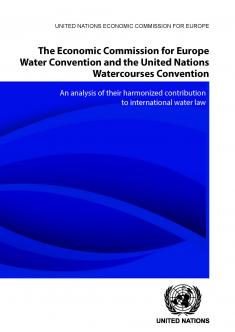Published:

Approximately 40 per cent of the world’s population live in river basins that cross national borders. Transboundary river basins cover nearly one half of the earth’s land surface and account for about 60 per cent of global freshwater flow. These basins link populations and create hydrological, social and economic interdependencies between countries. Transboundary water cooperation is therefore essential if we are to ensure the availability and sustainable management of water and sanitation for all. Legal agreements between and among countries can foster and secure transboundary water cooperation.
The opening of the United Nations Economic Commission for Europe (ECE) Convention on the Protection and Use of Transboundary Watercourses and International Lakes to all United Nations Member States in 2013, and the entry into force of the United Nations Convention on the Law of the Non-Navigational Uses of International Watercourses in 2014, has transformed treaty law for international waters. At the same time, suddenly having two treaties addressing the topic at the global level could create confusion.
This analysis by Attila Tanzi, Chair of the ECE Water Convention's Implementation Committee, is therefore timely and essential reading for those wishing to understand the contribution of the two Conventions to international water law, and provides reassurance as to their complementarity. That complementarity was recognized by United Nations Secretary-General Ban Ki-moon when he urged in 2012 that “the globalization of the [ECE Water] Convention should also go hand-in-hand with the expected entry into force of the United Nations Watercourses Convention. These two instruments are based on the same principles. They complement each other and should be implemented in a coherent manner.”
ECE/MP.WAT/42
Dowload this publication in English and French
The opening of the United Nations Economic Commission for Europe (ECE) Convention on the Protection and Use of Transboundary Watercourses and International Lakes to all United Nations Member States in 2013, and the entry into force of the United Nations Convention on the Law of the Non-Navigational Uses of International Watercourses in 2014, has transformed treaty law for international waters. At the same time, suddenly having two treaties addressing the topic at the global level could create confusion.
This analysis by Attila Tanzi, Chair of the ECE Water Convention's Implementation Committee, is therefore timely and essential reading for those wishing to understand the contribution of the two Conventions to international water law, and provides reassurance as to their complementarity. That complementarity was recognized by United Nations Secretary-General Ban Ki-moon when he urged in 2012 that “the globalization of the [ECE Water] Convention should also go hand-in-hand with the expected entry into force of the United Nations Watercourses Convention. These two instruments are based on the same principles. They complement each other and should be implemented in a coherent manner.”
ECE/MP.WAT/42
Dowload this publication in English and French